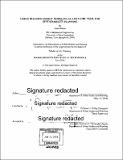| dc.contributor.advisor | J. Phillip Thompson. | en_US |
| dc.contributor.author | Bemis, Jamie (Jamie L.) | en_US |
| dc.contributor.other | Massachusetts Institute of Technology. Department of Urban Studies and Planning. | en_US |
| dc.coverage.spatial | n-us-ma | en_US |
| dc.date.accessioned | 2016-10-25T19:52:34Z | |
| dc.date.available | 2016-10-25T19:52:34Z | |
| dc.date.copyright | 2016 | en_US |
| dc.date.issued | 2016 | en_US |
| dc.identifier.uri | http://hdl.handle.net/1721.1/105072 | |
| dc.description | Thesis: M.C.P., Massachusetts Institute of Technology, Department of Urban Studies and Planning, 2016. | en_US |
| dc.description | Cataloged from PDF version of thesis. | en_US |
| dc.description | Includes bibliographical references (pages 33-34). | en_US |
| dc.description.abstract | Cities around the world are actively aiming to reduce greenhouse gas emissions in an effort to combat the negative consequences associated with anthropogenic climate change. The City of Boston is no exception-in 2011, then-mayor Tom Menino established the rigorous goals of reducing city-wide greenhouse gas emissions by 25% by 2020 and by 80% below 2005 levels by 2050. Given the realities of finite time and resources, it's critical to identify the most effective strategies to achieving energy efficiency in order to meet these objectives. This thesis explores how urban building energy modeling (UBEM) can be utilized to develop high-impact community-led energy efficiency programs. UBEM is a recently developed type of bottom-up energy modeling that presents a number of advantages over past urban energy modeling methods- namely, the ability for comparing complex scenarios, and the ability to generate hourly load profiles for individuals buildings. In addition, literature suggests that community-based energy efficiency programs achieve higher participation rates than traditional information-based programs. This thesis combines the technical benefits of UBEM with the practical advantages of community-led energy efficiency programs to develop a context-specific and community-based energy efficiency program for the Dudley Triangle neighborhood of Boston. It then explores how this type of a program can achieve the triple bottom line objectives of creating high quality local jobs, reducing environmental impacts, and supporting a local economy. | en_US |
| dc.description.statementofresponsibility | by Jamie Bemis. | en_US |
| dc.format.extent | 40 pages | en_US |
| dc.language.iso | eng | en_US |
| dc.publisher | Massachusetts Institute of Technology | en_US |
| dc.rights | M.I.T. theses are protected by copyright. They may be viewed from this source for any purpose, but reproduction or distribution in any format is prohibited without written permission. See provided URL for inquiries about permission. | en_US |
| dc.rights.uri | http://dspace.mit.edu/handle/1721.1/7582 | en_US |
| dc.subject | Urban Studies and Planning. | en_US |
| dc.title | Urban building energy modeling as a dynamic tool for sustainability planning | en_US |
| dc.title.alternative | UBEM as a dynamic tool for sustainability planning | en_US |
| dc.type | Thesis | en_US |
| dc.description.degree | M.C.P. | en_US |
| dc.contributor.department | Massachusetts Institute of Technology. Department of Urban Studies and Planning | |
| dc.identifier.oclc | 959888117 | en_US |
